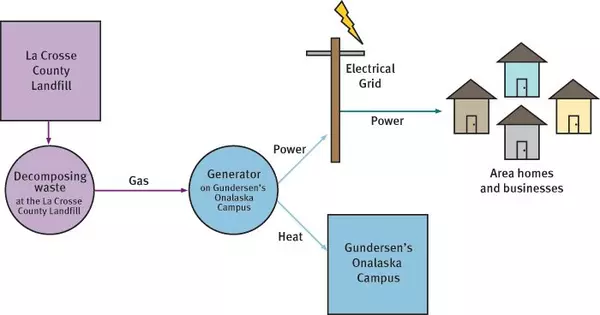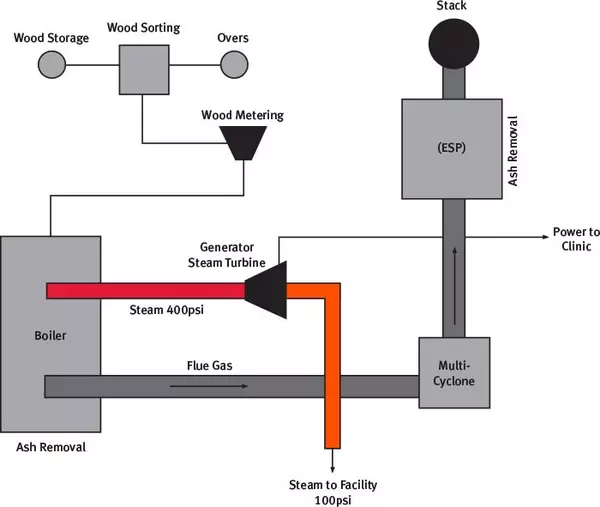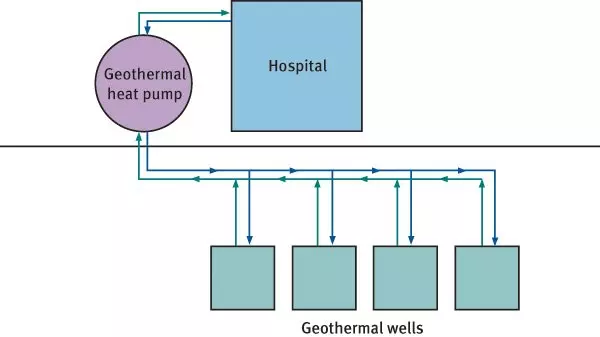Renewable Energy
Using elements of nature—such as biofuels, wind and the sun—to create power, reduces harmful emissions linked to human disease. Renewable energy allows organizations to use clean resources to power buildings.
Since 2008, we have implemented nearly a dozen renewable energy projects. We can help you navigate the roadblocks that can stand in the way of a successful renewable energy project—from executive buy-in to regulatory issues.
Biogas
Using waste to create energy
When you think "landfill" you probably don't think "renewable energy source." Think again! Gundersen partnered with La Crosse County on a project that captures waste biogas at the landfill and turns it into electricity and heat.
Enough energy is created to make one of Gundersen's multi-building campuses the only one in the country to be 100 percent energy independent.
How it works:
- Waste degrades underground at the landfill. As it decomposes, it gives off about 300 cubic feet of gas a minute. More than half of that is methane.
- The methane is captured and piped to an engine installed on the Gundersen Onalaska Campus.
- The gas powers an engine and turns a generator that produces electricity.
- The electricity is sent to the power grid and used by households and businesses throughout the community.
- The engine also creates heat, which is used to heat buildings and water on the Onalaska Campus.

The landfill project is an excellent use of a previously unused natural resource and is a wonderful example of what a public-private partnership can achieve in communities across the country.
Turning cow waste into energy
With the nickname "The Dairy State," it's a given that Wisconsin has a lot of cows. Those cows in turn create a lot of waste. Gundersen turns some of that waste into a usable renewable energy source with the development of two dairy digester projects.
In partnership with Dane County, Wis., and regional farm families, Gundersen developed the GL Dairy Biogas Project.
The GL Dairy Biogas digester is located outside Middleton, Wis., and generates about 16 million kilowatt hours of electricity annually, enough to power approximately 2,500 homes. The electricity is added to the local grid in Dane County through Madison Gas and Electric. The project not only reduces fossil fuel carbon dioxide by 11,000 metric tons per year, but creates a large amount of clean, organic-fiber by-product that has many horticultural uses and can be used as cow bedding.
The Sunny Side Digester near Sun Prairie, Wis., generates about 5 million kilowatt hours of electricity annually, enough to power about 530 homes a year. The electricity is added to the local grid in Dane County through Alliant Energy.
In addition to producing cleaner energy, the digesters prevent more than 3,700 pounds of phosphorus runoff to the water ways in Dane County every year. It is estimated that 370,000 pounds of algae will be reduced annually in the Yahara watershed as a result of this project.
View the Middleton case study View the Sun Prairie case study
How it works:
- Cow manure from the farms is processed in air-tight digester tanks.
- The tanks are heated to about 100 degrees, which creates the methane gas from the manure.
- The methane is captured at the top of the digester and burned in a generator to create electricity.
- The electricity is added to the local grid.
- The by-product is a clean, organic fiber that has many horticultural uses or is used by local farmers as cow bedding.

Biomass
Gundersen's boilers were a high user of fossil fuels, consuming much of the natural gas used to create heat for buildings. When it came time to replace aging boilers, Gundersen looked at the options and selected a biomass boiler.
The biomass boiler was - by far - the largest single project in the Envision® portfolio that helped Gundersen become energy independent.
How it works:
The biomass boiler uses clean organic wood fuel sources, such as milling or forest residues. These woody biomass products are sourced locally and have no paints, glues or treatments on the wood. The wood product is fed into the system, where it is burned and heats water to create steam used throughout Gundersen's La Crosse Campus. Gundersen uses state-of-the-art equipment to control emissions.
In addition, the biomass boiler project incorporates a steam turbine. Steam runs through the turbine and turns a motor to produce electricity. That electricity, enough to power about 225 homes a year, is used on-site by Gundersen, further reducing fossil fuel emissions. The biomass boiler saves Gundersen approximately $500,000 a year. The project was supported in part by a Wisconsin Bioenergy Grant.

Geothermal
A geothermal heat pump uses the earth as either a heating or cooling source. The system takes advantage of the moderate temperatures underground to greatly improve efficiencies of HVAC (heating and cooling) equipment. Gundersen installed a 300-ton heat pump along with 156 wells buried about 400 feet underneath a parking lot. At that depth, the ground is at a relatively constant temperature of roughly 48 degrees, providing an efficient heating and cooling source year-round.
How it works:
During the winter months, water from the geothermal wells is sent to the geothermal heat pump. There the energy (heat) from that water is used to add heat to the building. The water that had the energy removed is then sent back to the geothermal well to again have energy transferred to it from the earth. This method of heating is more efficient than burning fossil fuels.

The opposite happens in the summer months. The cool water inside the geothermal wells is sent to the geothermal heat pump where energy (heat) is transferred from the building to the water. The warmed water is then sent to the geothermal wells to transfer its heat back to the earth. This results in an efficient way to cool the building.
The geothermal heat pump system has a unique set up that allows for the heating to occur in the most efficient way. Heat is always being generated from medical equipment, electrical equipment and computer systems. The geothermal system captures this heat and sends it to areas where it can be used. By taking advantage of this heat, less energy is needed from the geothermal wells in the winter, thus increasing the efficiency of the system.
The geothermal heat pump results in a savings of 70 to 80 kBTU per square foot annually, by far the largest energy saving component of Gundersen's new hospital.
Microgrid
Gundersen Tomah Clinic features backup battery power
Solar photovoltaic
Blue ramp solar project
Solar panels above our Blue Ramp at the Gundersen Lutheran Medical Center in La Crosse will produce 1,000 Megawatt hours (MWh) of electricity directly for our hospital each year, enough to power 10,600 homes annually and offset 10% of our energy use.
A green upgrade at Gundersen
Gundersen has been working hard over the last decade to reduce energy usage and generate power from clean, renewable resources, and recently strengthened those efforts by installing 375 solar panels on the roof of its Behavioral Health building. The power will directly feed the building and if more electricity is generated than needed, the power will be sent back and used in Gundersen's on-site power plant.
The Behavioral Health building's open roof and size make it an ideal location for the panels. Not only will it improve the health of the environment, it's estimated that the project will save Gundersen about $15,000 per year, with the financial benefits increasing over time.
Gundersen grows sustainable footprint
Gundersen Health System's 35,000-square foot Clinic in Sparta, Wis., is a shining example of the healthcare leader's commitment to improve the health of the environment and the communities it serves by increasingly powering its buildings with clean, renewable energy.
An array of solar photovoltaic panels capable of producing 100 kilowatts of energy sits on the roof of the new Clinic, which was under construction from October 2015 until it opened in January 2017. Gundersen also has purchased 220 kilowatts of solar energy from a nearby Xcel Energy community solar garden to help power the building. This combination of solar panels provides the Clinic with 320 kilowatts of renewable energy at peak production, enough to offset the building's consumption.
Solar panels a visible reminder of environmental stewardship
As part of ongoing energy efficiency efforts, new buildings at Gundersen are designed with the environment, staff and patients in mind. One example is the underground parking ramp that opened on Gundersen's La Crosse, Wis., campus in 2008.
The parking ramp was designed with a number of "green" elements. The most visible elements are the solar panels on the roof that produce electricity to help power the structure. The electricity generated by the solar panels could power six to seven homes.
The solar panels are just one element of the ramp that helped it become one of the nation's first LEED (Leadership in Energy and Environmental Design)-certified parking structures in the country. LEED is the nationally accepted benchmark for the design, construction and operation of high-performance green buildings.
Other design elements include:
- EnviroGLAS™ flooring and countertops with 100 percent recycled glass.
- Environmentally friendly paint.
- Recycling of all construction waste on the job.
Renewable energy emanates from Gundersen Onalaska Clinic
The healthcare provider recently installed 912 solar photovoltaic panels on the roof of its Onalaska Clinic.
The solar panels will provide 300 kilowatts of energy at peak production, an amount that is expected to lower Gundersen's annual energy expenses by up to $45,000—all while bettering the health of the neighborhoods the healthcare provider serves.
Gundersen's campus in Onalaska already is considered energy independent, meaning that it produces more energy by way of renewable resources than it uses from conventional utilities. Much of this energy is created by Gundersen's landfill generator project, a partnership with La Crosse County that captures waste biogas at the county landfill and turns it into electricity and heat via a generator on the Gundersen campus. The electricity not used by the campus is sold to the utilities.
Support Services Building solar panels
In 2014, Gundersen Health System became the first known healthcare system to offset 100 percent of its fossil fuel use with locally produced energy. The organization now is building upon its success as a leader in clean healthcare by improving the energy independence of its individual sites. On Gundersen's campus in Onalaska, Wis., this includes the addition of solar panels on the roof of its Support Services Building.
Equipping the Support Services Building with solar panels is just the latest in Gundersen's clean-energy efforts in Onalaska.
Solar hot water
Most child care centers use a large amount of hot water each day, and Gundersen's Child Care Center is no exception. The dishwasher is often running to sterilize dishes, bottles, utensils and toys, and the staff does six to eight loads of laundry a day.
Rather than relying solely on a traditional hot water heater, the Child Care Center is relying on the sun. In 2010, Gundersen completed the installation of a solar hot water heater at the Center.
How it works:
- Black panels were installed on the roof of the Child Care Center.
- A glycol/water mix runs through coils in the panels, and the sun heats up the fluid. That fluid passes through a heat exchanger, which heats up the cold incoming water from the City.
- The hot water is ready to use in the building.
- If the solar-heated water isn't quite hot enough, a traditional hot water heater activates and heats the water further before it is sent to dishwashers, washing machines, sinks, etc.
As a unique feature, a computer installed in the Child Care Center monitors how much energy is being harnessed from the sun. With the installation of the solar hot water heater, about 85 percent of the Child Care Center's hot water needs have been offset.
A solar thermal water heating system is used at Gundersen's Onalaska Campus Renal Dialysis Center.
Wind
Gundersen harnesses energy from the wind to create electricity. They built a two-turbine wind farm just north of Lewiston, Minn. and partnered with Organic Valley to build a two-turbine wind farm near Cashton, Wis., known as Cashton Greens Wind Farm.
The wind farm in Lewiston is generating 4.95 megawatts of energy, enough to power about 1,400 homes. Cashton Greens Wind Farm is generating nearly 5 megawatts of energy, enough electricity to power approximately 1,200 homes each year.
The electricity is fed into the energy grid and used by homes and businesses. Gundersen, in turn, is paid for the energy created by the turbines in Lewiston, and Gundersen and Organic Valley are paid for the energy created in Cashton.
Contact us
Gundersen Envision®
1900 South Avenue
La Crosse, WI 54601
Phone:
(608) 775-0880
(855) 669-1653 (toll-free)
Email:
[email protected]
Other programs
Related videos
- AJAM: Wisconsin hospital uses alternative energy December 23, 2014
- MSNBC: Wisconsin hospital achieves energy independence November 12, 2014
- Gundersen Energy Independence news conference November 10, 2014
- Gundersen reaches first days of energy independence November 6, 2014
- Gundersen's dairy biogas renewable energy project November 3, 2014
- Tips for being green May 29, 2014
- Cashton wind farm February 26, 2014
- Lewiston wind farm February 25, 2014
- Landfill gas to energy project December 6, 2013
- Biomass combined heat and power October 15, 2013
- Gundersen powers up biomass boiler May 3, 2013
Related photos
- Biomass boiler December 5, 2016
- Cashton wind energy project December 4, 2016
- Lewiston wind energy project December 3, 2016
- Landfill energy project December 2, 2016
- Middleton dairy digester December 1, 2016
- Sun Prairie dairy digester November 30, 2016
- Solar thermal water heating November 29, 2016
- Geothermal heat pump November 28, 2016